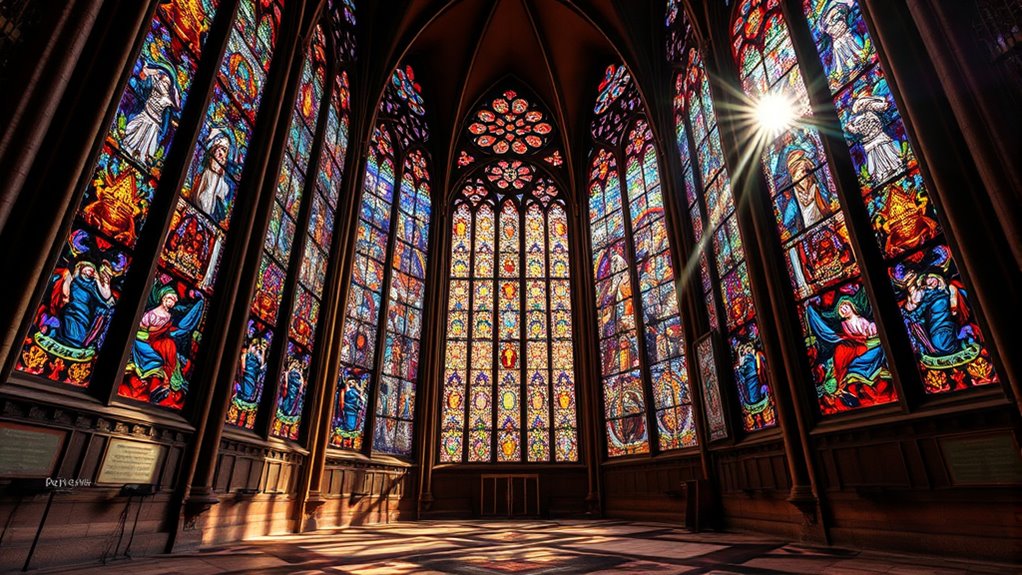Stained glass windows in cathedrals have evolved from locally crafted, intricate designs during medieval times to sophisticated masterpieces that blend traditional craftsmanship with modern technology. Historically, skilled artisans created detailed scenes to tell stories and inspire faith, while today, digital tools and new materials allow for richer colors and larger, more durable windows. This seamless blend enhances the storytelling power of light in sacred spaces. Explore further to discover how technology continues to shape this timeless art form.
Key Takeaways
- Medieval craftsmanship created intricate stained glass windows that served as visual sermons and illuminated cathedrals with colorful light.
- Technological innovations during the Renaissance enhanced window complexity, hues, and storytelling capabilities.
- Modern techniques, including computerized design and advanced materials, improve durability and allow for larger, detailed windows.
- Combining traditional methods with digital tools enables personalized, complex stained glass designs and restoration of historic windows.
- The evolution of stained glass reflects technological progress, artistic expression, and cultural influences, preserving its spiritual and artistic significance.

Stained glass has transformed dramatically over centuries, reflecting advances in technology, artistry, and cultural influences. During the medieval period, artisans relied heavily on medieval craftsmanship to create their intricate designs. You can imagine how skilled craftsmen carefully cut colored glass and assembled it with lead cames, forming detailed scenes that told stories and conveyed religious messages. These windows weren’t just decorative; they served as visual sermons, illuminating the interior of cathedrals with colorful light that seemed almost divine. The process was painstaking, requiring patience and precision, as every piece had to fit perfectly within the overall design. The artistry involved in medieval craftsmanship was remarkable, often passed down through generations, ensuring that each piece carried the legacy of its creators.
As time progressed, the techniques for making stained glass evolved considerably. The Renaissance and subsequent periods introduced new methods for color application and glass production. You might notice how these innovations allowed for richer hues and more complex imagery, enhancing the storytelling aspect of cathedral windows. However, it’s not just about aesthetic improvements. The evolution also meant greater durability and efficiency in creating large-scale windows. Today, modern techniques have transformed stained glass into a versatile art form. Using advanced tools like computerized design software, artists can plan intricate patterns with unmatched precision before the glass is even cut. Modern methods also incorporate new types of glass and chemical treatments that make the windows more resistant to weathering. This technological progress means that stained glass can withstand the test of time better than ever before, while still capturing the vibrant colors and detailed images that make it so mesmerizing.
You can see how the blend of medieval craftsmanship and modern techniques shapes the evolution of stained glass. The craftsmanship of the past laid a foundation of skill and artistry, while contemporary innovations expand the possibilities of design and durability. Today’s artisans often combine traditional methods with digital tools, allowing for more complex and personalized creations. Whether restoring historic windows or designing new ones, you’re witnessing a continuous dialogue between the old and the new. The evolution of stained glass isn’t just about improving materials or techniques; it’s about preserving the spiritual and artistic essence that transforms light into a powerful storytelling medium inside cathedrals. By understanding this progression, you gain a deeper appreciation for how stained glass has become a timeless symbol of faith, artistry, and human ingenuity.
Frequently Asked Questions
How Did Stained Glass Techniques Spread Across Europe?
You see, stained glass techniques spread across Europe through medieval craftsmanship and apprenticeships, enabling artisans to share skills. Regional styles emerged as craftsmen adapted designs to local tastes and resources. Traveling master glassmakers also contributed, transferring knowledge and techniques from one area to another. Over time, this exchange fostered diverse stained glass traditions, enriching the art form and allowing stunning cathedral windows to become symbols of regional identity and religious devotion.
What Symbols Are Most Common in Cathedral Stained Glass?
Symbols in cathedral stained glass are like a visual language for the faithful. You’ll often see biblical imagery such as saints, angels, and scenes from the life of Christ, along with symbolic motifs like the cross, lambs, and doves. These images serve to educate and inspire, conveying spiritual truths through vibrant colors and intricate designs that capture your attention and deepen your faith.
Who Were the Key Artisans Behind Historic Stained Glass Windows?
You should know that medieval craftsmanship and artisan guilds played a vital role in creating historic stained glass windows. Skilled artisans, often members of guilds, meticulously designed and assembled these masterpieces. They used techniques passed down through generations, ensuring quality and artistry. These craftsmen combined their talents to produce vibrant, intricate windows that told religious stories and illuminated cathedral interiors, reflecting the dedication and collaborative effort of medieval artisan guilds.
How Did Stained Glass Influence Religious Practices?
Did you know that stained glass windows can refract light at over a 100-degree angle, creating a mesmerizing glow? This effect enhances biblical storytelling by illustrating sacred scenes vividly, helping worshippers connect spiritually. As light filters through, it transforms church interiors, making divine messages more immersive. You experience a sense of awe that deepens faith, turning the act of viewing into a sacred journey through biblical history.
Are There Modern Innovations in Stained Glass Art Today?
Today, modern stained glass art features innovative materials like LED backlighting and digital design techniques. You’ll find artists experimenting with vibrant, dynamic colors and intricate patterns that were impossible before. Digital design allows for precise, complex imagery, making stained glass more versatile and expressive. These innovations create stunning visual effects, blending tradition with technology, and transforming how you experience light and color in contemporary stained glass art.
Conclusion
As you’ve seen, stained glass has transformed from simple colored windows into breathtaking masterpieces that fill cathedrals with divine light. Every piece, every hue, tells a story of innovation and faith that’s endured for centuries. You now hold the key to understanding how these luminous works of art shape spiritual experience. Honestly, the beauty of stained glass can outshine the sun itself—its timeless glow continues to inspire awe beyond imagination.









